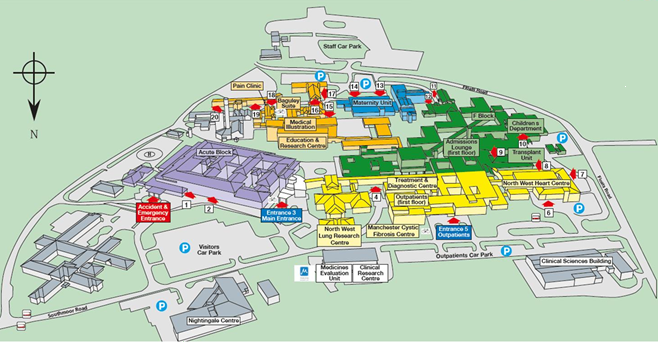Opening hours
The histology/cytology laboratory is open Monday – Friday from 8am until 5.30pm, excluding public holidays. Outside these hours relevant personnel are on call for dealing with urgent cardio-thoracic transplant biopsies. Notice needs to be given to the Consultant Histopathologist and the Biomedical Scientist of the intention to perform a biopsy and to the Biomedical Scientist when the specimen is dispatched for transport to pathology who is contactable through switch and ask for the cardio-thoracic Biomedical Scientist on call.
The Mortuary is open from 8.30am until 4pm and Anatomical Pathology Technicians operate a limited on-call service. They can be contacted via the duty manager in the first instance.
Location
Our reception is located on the ground floor of the Clinical Sciences Building at Wythenshawe Hospital:
Address:
Histopathology and Cytopathology (Cellular Pathology)
Clinical Sciences Building
Wythenshawe Hospital
Southmoor Road
Wythenshawe
Manchester
M23 9LT
Contact information
Histology reports
| Generic contact details | Location | Extension | Information |
| Report enquiries | Office | 0161 291 4813 | At times, this number may have an answering machine: please leave a clear request and a number for us to call you back |
| Departmental nhs.net email address | Mft.wythenshawe.histosecs@nhs,net |
All enquiries for histology reports should be directed to our secretarial office.
All enquiries regarding frozen sections, specimen requesting, labelling, transport and requirements should be directed to our Specimen Reception (details below).
Key Contact Details
| Laboratory | Tel No. | Email address |
| John Hayes
Cellular Pathology Directorate Manager
|
0161 276 6138 | John.hayes@mft.nhs.uk |
| Katherine Congdon
Cellular Pathology Deputy Directorate Manager / Histopathology Laboratory Manager |
0161 276 6138 | katherine.congdon@mft.nhs.uk |
| Catherine McNulty Lead Biomedical Scientist | 0161 291 4804 | Catherine.mcnulty@mft.nhs.uk |
| Christopher Harreld Deputy Lead Biomedical Scientist | 0161 291 4804 | Christopher.harreld@mft.nhs.uk |
| Specimen reception | 0161 291 4800 | |
| Histology laboratory | 0161 291 4800 | |
| Cytology laboratory | 0161 291 2156 |
| Consultant Name and Speciality | Office | Secretary | Email address |
| Dr Edmund Cheesman
Clinical Director of Cellular Pathology |
0161 701 2375 | 0161 701 1272 | edmund.cheesman@mft.nhs.uk |
| Dr M Scott
Co-Clinical Lead Histopathology Gynaecology, Gastrointestinal, Urology |
0161 291 2144 | 0161 291 2123 | michael.scott@mft.nhs.uk |
| Dr N Ali
Breast, Skin, Gynaecology, Gastrointestinal cytology |
0161 291 5663 | 0161 291 4812 | nisha.ali@mft.nhs.uk |
| Dr P Bishop
Cardiothoracic, Skin, Head & Neck, Haematolymphoid Andrology |
0161 291 2159 | 0161 291 2121 | paul.bishop2@mft.nhs.uk |
| Dr A Davenport (part-time)
Co-Clinical Lead Histopathology Gastrointestinal |
0161 291 5311 | 0161 291 2143 | anna.davenport@mft.nhs.uk |
| Dr Angeles Montero
|
0161 291 4786 | 0161 291 2123 | Angeles.montero@mft.nhs.uk |
| Dr R. Hunt
Breast, Gastrointestinal, Gynaecology, Urology, Gastrointestinal cytology |
0161 291 4807 | 0161 291 4812 | roger.hunt@mft.nhs.uk |
| Dr L Joseph
Deputy Clinical Head of Division, Quality and Patient Safety Lead & Co-Clinical Lead Histopathology Skin, Breast, Cardiothoracic |
0161 291 4808 | 0161 291 2123 | leena.joseph@mft.nhs.uk |
| Dr S Pritchard
Co-Clinical Lead Histopathology Breast, Gastrointestinal, Head & Neck, Gastrointestinal cytology |
0161 291 4818 | 0161 291 2143 | susan.pritchard@mft.nhs.uk |
| Dr A Paivi-Correia
Cardiothoracic, max fax |
0161 291 4805 | 0161 291 4810 | Antonio.PaivaCorreia@mft.nhs.uk |
| Dr Kavita Singhal
Breast, Skin |
0161 291 4793 | 0161 291 2123 | Kavita.singhal@mft.nhs.uk |
| Dr Nadine Elgeredly
Breast,, Urology, Gastrointestinal |
0161 291 2819 | 0161 291 2121 | Nadine.elgeredly@mft.nhs.uk |
| Speciality trainees | 0161 291 4814
0161 291 4816 |
0161 291 4815
0161 291 4817 |
(Last reviewed April 2023)
 In this section
In this section
